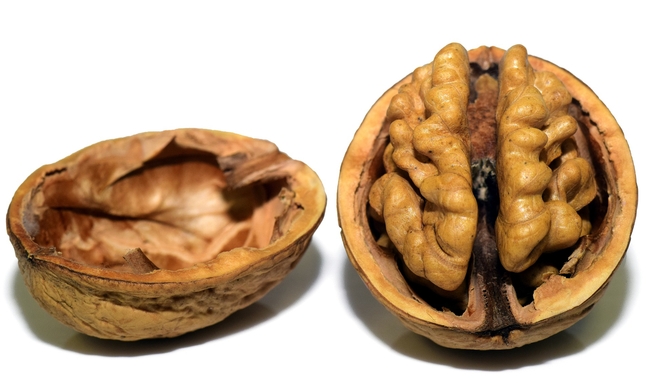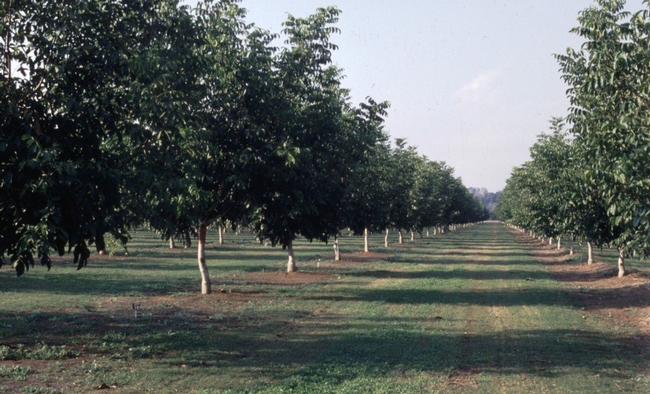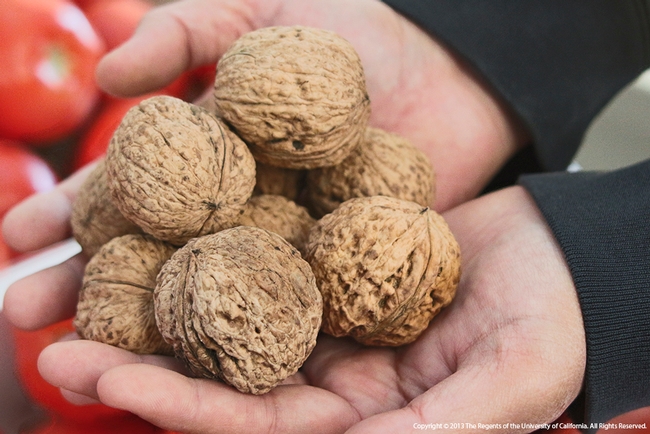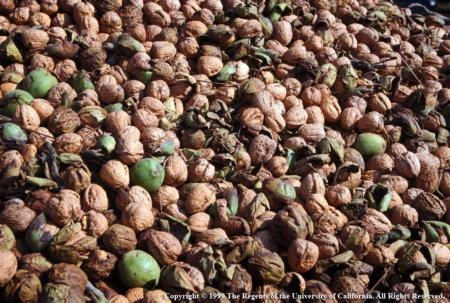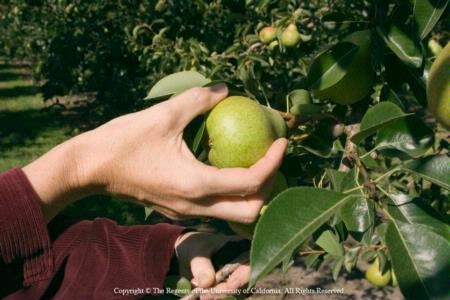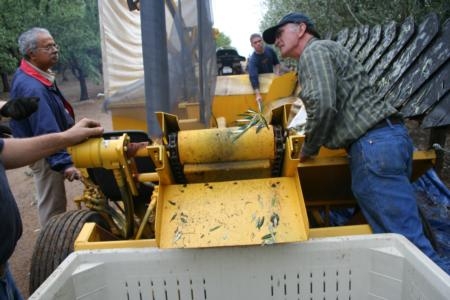Posts Tagged: walnuts
New cost and return study for walnuts released by UC Agricultural Issues Center
The UC Agricultural Issues Center has released a new study on the costs and returns to establish an orchard and produce walnuts in the northern San Joaquin Valley.
This study assumes a hypothetical farm size of 100 contiguous acres that is farmer owned and operated. Sixty acres are being established to walnuts and 35 acres are planted to other permanent or annual crops. The walnut orchard is planted on a 24-by-24-foot spacing using three-quarters inch caliber nursery grafted trees on a Paradox rootstock. The walnut trees are a late leafing, lateral bearing variety.
Input and reviews were provided by UC Cooperative Extension farm advisors and other agricultural associates. The authors describe the assumptions used to identify current costs for the walnut crop, material inputs, cash overhead, and non-cash overhead. Ranging analysis tables show net profits over a range of prices and yields. Other tables show the monthly cash costs, the costs and returns per acre, hourly equipment costs, and the whole farm annual equipment, investment and business overhead costs.
The new study is titled: "Sample Costs to Establish an Orchard and Produce Walnuts, in the San Joaquin Valley North – 2017"
This study and other sample cost of production studies for many commodities are available for download on the UC Davis Department of Agricultural and Resource Economics website at http://coststudies.ucdavis.edu.
For additional information or an explanation of the calculations used in the studies, contact Jeremy Murdock at the Agricultural Issues Center at (530) 752-4651, jmmurdock@ucdavis.edu, or UCCE advisors Joe Grant, jagrant@ucanr.edu, David Doll, dadoll@ucanr.edu, or Janet Caprile, jlcaprile@ucanr.edu.
New cost study for English walnuts released by Agricultural Issues Center
The economic life of the orchard used in this cost analysis is 30 years. The analysis is based upon a hypothetical farm operation of a well-managed orchard, using practices common to the region. Growers, UC ANR Cooperative Extension farm advisors and other agricultural associates provided input and reviews. Assumptions used to identify current costs for the walnut crop, material inputs, cash and non-cash overhead are described. A ranging analysis table shows profits over a range of prices and yields. Other tables show the monthly cash costs, the costs and returns per acre, hourly equipment costs, and the whole farm annual equipment, investment and business overhead costs.
The new study is titled “2015 Sample Costs to Establish and Produce English Walnuts in the Sacramento Valley, Microsprinkler Irrigated.”
This study and other sample cost of production studies for many commodities are available. They can be downloaded for free from the UC Davis Department of Agriculture and Resource Economics website at http://coststudies.ucdavis.edu.
For additional information or an explanation of the calculations used in the studies, contact Don Stewart at the UC ANR Agricultural Issues Center at (530) 752-4651 or destewart@ucdavis.edu.
UC estimates production costs for walnuts, wine grapes, hay, blackeye beans
New studies showing production costs for conventionally and organically grown walnuts, organic alfalfa hay, wine grapes and single- and double-cropped blackeye beans are now available from the University of California Cooperative Extension.
Each analysis is based upon hypothetical farm operations using practices common in the region. Input and reviews were provided by UC Cooperative Extension farm advisors, researchers, growers, farm accountants, pest control advisers, consultants and other agricultural associates.
Each report describes the assumptions used to identify current costs for the individual crops, material inputs, cash and non-cash overhead. A ranging analysis table shows profits over a range of prices and yields. Other tables show the monthly cash costs, the costs and returns per acre, hourly equipment costs, and the whole farm annual equipment, investment and business overhead costs.
The six new cost studies are the following:
- Sample Costs to Produce Organic Walnuts, 2013, North Coast by Rachel B. Elkins, Karen M. Klonsky and Richard L. De Moura.
- Sample Costs to Produce Organic Alfalfa Hay, 2013, California by Rachael F. Long, Steve B. Orloff, Karen M. Klonsky and Richard L. De Moura.
- Sample Costs to Establish and Produce Walnuts, 2013, Northern San Joaquin Valley by Joseph A. Grant, Janet L. Caprile, David A. Doll, Kathleen Kelly Anderson, Karen M. Klonsky and Richard L. De Moura.
- Sample Costs to Establish and Produce Wine Grapes, 2013, Sacramento Valley by Chuck A. Ingels, Karen M. Klonsky and Richard L. De Moura.
- Sample Costs to Produce Blackeye Beans (double-cropped), 2013, Southern San Joaquin Valley and Sample Costs to Produce Blackeye Beans (single-cropped), 2013, Southern San Joaquin Valley by Carol A. Frate, Karen M. Klonsky and Richard L. De Moura.
The cost of production studies for these and other crops are available online at http://coststudies.ucdavis.edu, at UC Cooperative Extension offices or by calling (530) 752-3589.
For additional information about the studies, contact Richard De Moura at rdemoura@ucdavis.edu.
UC studies examine costs for growing pears, walnuts, winegrapes
UC studies examine costs for growing pears, walnuts, winegrapes
New studies showing production costs for pears, organic pears, walnuts and cabernet sauvignon winegrapes are now available from the University of California Cooperative Extension.
Analysis for each crop is based upon hypothetical farm operations using practices common in the region. Input and reviews were provided by UC Cooperative Extension farm advisors, researchers, growers, farm accountants, pest control advisers, consultants and other agricultural associates.
The studies describe the assumptions used to identify current costs for the individual crops, material inputs, cash and non-cash overhead. A ranging analysis table shows profits over a range of prices and yields. Other tables show the monthly cash costs, the costs and returns per acre, hourly equipment costs and the whole farm annual equipment, investment and business overhead costs.
The four new cost studies are the following:
- Sample Costs to Establish and Produce Pears, 2012, North Coast, by Rachel B. Elkins, Karen M. Klonsky and Kabir P. Tumber.
- Sample Costs to Produce Organic Pears, 2012, Sacramento Valley, by Chuck A. Ingels and Karen M. Klonsky.
- Sample Costs to Establish a Walnut Orchard and Produce Walnuts, 2012, North Coast, by Rachel B. Elkins, Karen M. Klonsky and Kabir P. Tumber.
- Sample Costs to Establish a Vineyard and Produce Winegrapes (Cabernet Sauvignon), 2012, San Joaquin Valley North, by Paul S. Verdegaal, Karen M. Klonsky and Richard L. De Moura.
These cost studies and cost of production studies for other crops are available online at http://coststudies.ucdavis.edu, at UC Cooperative Extension offices and by calling (530) 752-3589. For more information about the studies, contact Richard De Moura at rdemoura@ucdavis.edu in the UC Davis Department of Agricultural and Resource Economics.
Krueger wraps up 32-year career as UCCE tree crop advisor
“When I started, there were about 22,000 acres, now there are more than 68,000 acres,” said Krueger, who retired July 1 as UCCE advisor in Glenn and Tehama counties and director for UCCE in Glenn County. Part of that expansion can be attributed to Krueger’s research showing how almonds and walnuts can be produced on marginal soils with high density plantings and drip irrigation.
“Bill Krueger is a great asset to our agricultural community,” said Erick Nielsen, who grows prunes and olives in Orland.
“We have enjoyed working with Bill for many years,” Nielsen said. “He has always been the kind of guy to just jump right in and help. We have appreciated his dedication to agricultural research and his knowledgeable guidance.”
Raised on a farm in Prosser, Wash., Krueger was introduced to farming by his parents, who grew Concord grapes and cherries. He earned his bachelor’s and master’s degrees in horticulture at Washington State University, then worked for a year as foreman at Mt. Adams Orchard Company in White Salmon, Wash., tending cherries, apples and pears.
In 1980, Krueger moved to California to become the UC Cooperative Extension advisor for tree crops in Glenn County.
“I’ve spent my entire career in Glenn County,” remarked Krueger, who specializes in production of almonds, walnuts, prunes and olives.
Seeking opportunities for growers to diversify their crops, Krueger and his fellow UC Cooperative Extension advisor John Edstrom planted a test plot of walnut trees at the Nickels Soil Laboratory in Arbuckle in 1986.
They set up a walnut orchard with 202 trees per acre, much closer than the 60 trees per acre of a traditional orchard. The two varieties that Krueger and Edstrom planted produce a large proportion of walnuts on lateral buds, which allows for hedgerow planting and mechanical pruning. Each year, a giant hedger with eight 38-inch saws buzzed down one side of the tree rows, cropping back branches and encouraging production. In alternate years, they pruned the opposite side of the trees. Rather than being flood irrigated as most walnut orchards, the Nickels orchard was watered and fertilized using drip irrigation.
Crop yields from the dense walnut tree plantings compensated for the marginal soils. The successful demonstration plot led to thousands of acres of walnuts being planted on similar soils.
In 1992, he added responsibility for olives in Tehama County, where the number of acres of olive trees has doubled from 4,000 acres to approximately 8,000 acres. Krueger is internationally respected for his research identifying the most effective method of chemically thinning olives to increase the size of the fruit. Chemical thinning of olives has become a common practice among Sacramento Valley table olive growers.
Over the years, he has collaborated on the development of integrated pest management practices for almonds, walnuts and prunes. In 2004, Krueger was a member of the team that California Department of Pesticide Regulation honored with its IPM innovator award for the Integrated Prune Farming Practices Program.
“Over the years he has assisted us with many different pruning trials in both our olive and prune orchards,” said Nielsen. “The last project he helped us work on was a trial for various degrees of hand pruning versus mechanical pruning in prunes. Bill has a great sense of the current market for the different crops and has always been a front-runner on moving forward with research and development projects.”
Krueger developed pruning strategies to enhance early production of prunes while developing tree structure capable of supporting heavy crop loads. He helped refine mechanical thinning to manage prune crop size, a technique developed earlier by UC researchers, and his efforts to extend this research to growers helped it become a common practice when needed.
His work, in collaboration with others, on reduced pruning of almonds has helped growers save money by reducing pruning costs.
In addition to advising growers, Krueger served a total of 13 years as director for UCCE in Glenn County, from 1996 to 2001, then resuming the helm from 2004 until his retirement.
Krueger has applied for emeritus status with UC so that he can finish up a few projects, but also looks forward to working on his own 10-acre olive orchard south of Orland during his retirement.
On Aug. 17, Krueger will be celebrating his career with friends and colleagues at Mills Orchards in Hamilton City. For details, contact Jody Samons at (530) 865-1155 or jesamons@ucdavis.edu.

